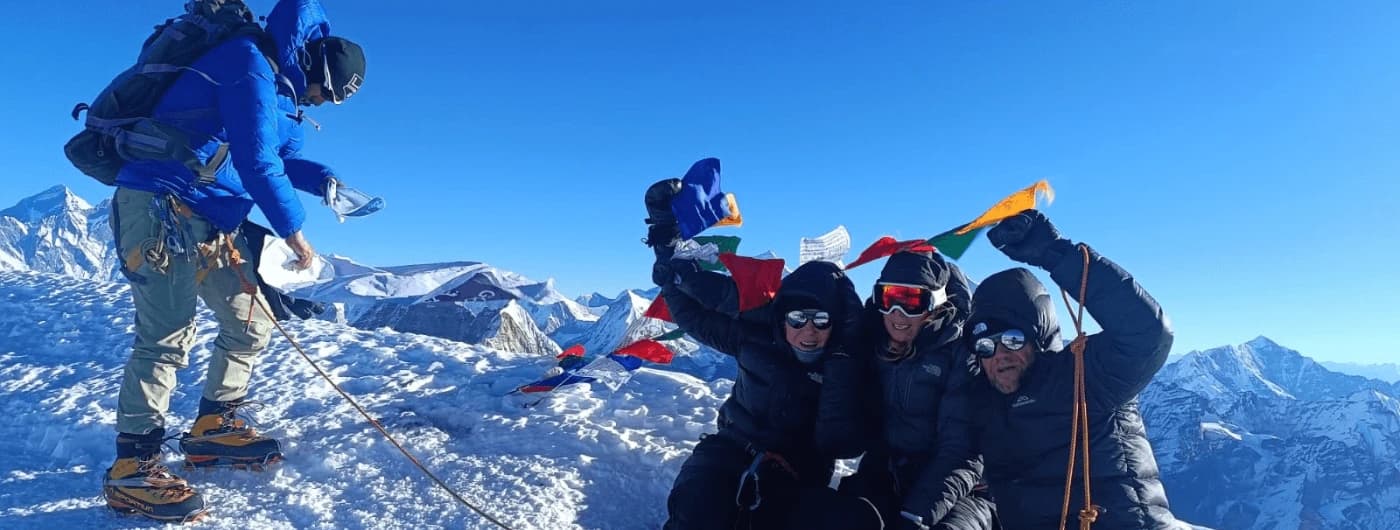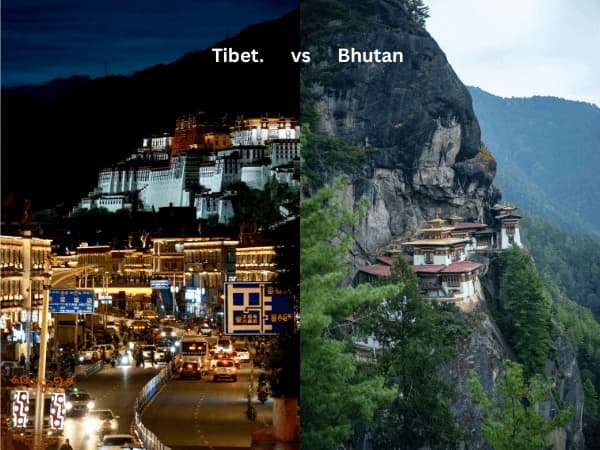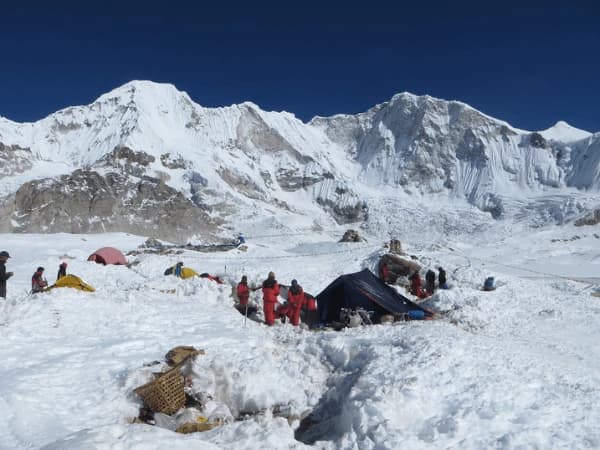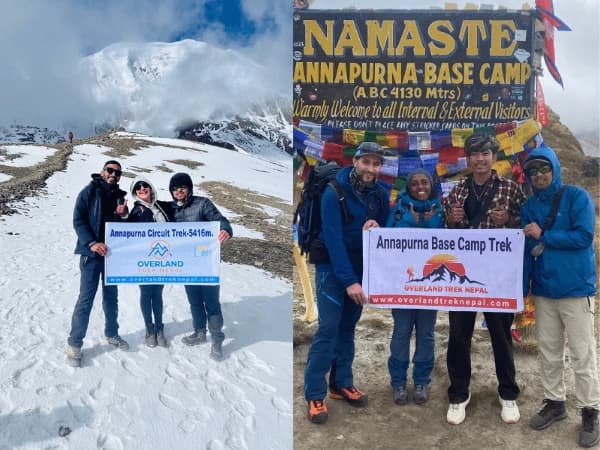Mera Peak stands as Nepal's highest trekking peak, offering adventurers a unique blend of challenge and breathtaking Himalayan vistas. This comprehensive guide provides insights into climbing Mera Peak, including itineraries, costs, route maps, and frequently asked questions to prepare you for this epic ascent. Trekking Peaks in Nepal offers an epic mountaineering experience for beginners to experienced climbers. Let’s dive into why you should choose Mera Peak and discover Nepal’s highest trekking peak.
The Highest Trekking Peak in Nepal, Mera Peak Guide 2025
Conquer the Highest Trekking Peak of Nepal, Mera Peak
Nestled in the heart of the Himalayas, Mera Peak rises to an impressive 6,476 meters, earning its title as the Highest Trekking Peak in Nepal. Situated in the Mahalangur section, Barun sub-section of the Himalaya, it offers climbers panoramic views of five of the world's highest mountains: Everest, Lhotse, Cho Oyu, Makalu, and Kanchenjunga.
The journey to Mera Peak takes adventurers through remote villages and diverse landscapes, offering a glimpse into the rich culture and natural beauty of Nepal. The trek begins with a flight to Lukla, followed by a trek through the Hinku Valley, passing through rhododendron forests and alpine meadows before reaching the glacier-covered slopes of Mera Peak.
Climbing Mera Peak involves traversing glaciers and snowfields, but it is considered non-technical, making it an ideal objective for trekkers seeking to experience high-altitude mountaineering without the complexities of more technical climbs.
Unlike technical expeditions, Mera Peak is ideal for experienced trekkers with basic mountaineering skills. The climb combines classic Himalayan trekking with the thrill of a high-altitude summit—an accessible dream for adventure seekers worldwide.
In summary, Mera Peak's significant elevation and its classification as a trekking peak by the NMA establish it as the highest trekking peak in Nepal, offering climbers a challenging yet accessible high-altitude adventure.

Why is Mera Peak the highest trekking peak of Nepal?
Mera Peak is recognized as the highest trekking peak in Nepal due to its elevation of 6,476 meters (21,247 feet) and its classification by the Nepal Mountaineering Association (NMA) as a "trekking peak." This designation is reserved for peaks that are accessible to climbers with basic mountaineering skills and do not require extensive technical expertise.
The NMA categorizes peaks into Group "A" (expedition peaks) and Group "B" (trekking peaks), with Mera Peak falling into the latter category. Despite some confusion in the past regarding its exact elevation and classification, Mera Peak's status as the highest trekking peak has been clarified and affirmed.
Climbing Mera Peak involves traversing glaciers and snowfields, but it is considered non-technical, making it an ideal objective for trekkers seeking to experience high-altitude mountaineering without the complexities of more technical climbs.
In summary, Mera Peak's significant elevation and its classification as a trekking peak by the NMA establish it as the highest trekking peak in Nepal, offering climbers a challenging yet accessible high-altitude adventure.

Why Choose Mera Peak?
- Accessibility for Trekkers: Despite its altitude, Mera Peak is considered a non-technical climb, making it suitable for trekkers with good physical fitness and basic mountaineering skills.
- Stunning Panoramas: The summit offers unparalleled views of the Himalayan giants, providing a rewarding experience for those who reach the top.
- Cultural Immersion: The journey to Mera Peak takes you through remote villages and diverse landscapes, offering a glimpse into the rich culture and natural beauty of Nepal.
Mera Peak Climbing Itinerary for 2025, 2026
A typical Mera Peak climbing itinerary spans 12 to 18 days, depending on acclimatization needs and chosen routes. Here is the 12-day Mera Peak climbing Itinerary from Kathmandu.
Day 1: Fly from Kathmandu to Lukla (2,840 m); Trek to Chutanga (3,020 m)
The trip begins with a scenic mountain flight to Lukla. After meeting the crew, the trek starts through rhododendron and pine forests, leading to the small settlement of Chutanga. It’s a short, gentle 3–4-hour trek designed to aid in acclimatization for the journey ahead.
Day 2: Trek to Thuli Kharka (4,300 m) via Zatrwa La Pass (4,610 m)
A challenging day as we ascend steadily to Zatrwa La Pass, which opens to expansive views of Kongde Ri and other surrounding peaks. After crossing the pass, we descend into the Hinku Valley and reach Thuli Kharka, a remote pasture area with simple lodges. The day’s trek takes around 6–7 hours.
Day 3: Trek to Kothe (3,600 m)
Descending through forests of fir and rhododendron, the trail winds along the west side of the Hinku Valley. We gradually lose altitude and breathe more easily as we approach Kothe. Views of Mera Peak begin to appear in the distance. The trek lasts around 5 hours.
Day 4: Trek to Thagnak (4,350 m)
The route continues along the Hinku Khola River, moving into more rugged alpine terrain. We pass yak herders’ shelters and the tiny outpost of Lungde before reaching Thagnak. With Mera Peak looming ever closer, the 5-hour hike offers impressive scenery and solitude.
Day 5: Trek to Khare (5,045 m)
The trail ascends over rocky moraines beside the Dig Glacier and along the beautiful glacial lake of Sabai Tso. Though shorter in distance (4–5 hours), the high altitude makes it physically demanding. Khare, the base camp for Mera Peak, sits beneath Mera La Pass and offers magnificent views.
Day 6: Acclimatization and Training Day at Khare
A full day at Khare is spent acclimatizing to the elevation. In the morning, a practical training session introduces climbers to basic mountaineering equipment like crampons, ropes, and ice axes. The rest of the day is for rest, hydration, and mental preparation.
Day 7: Trek to Mera High Camp (5,780 m)
We climb to Mera La Pass and traverse the Mera Glacier to reach High Camp. The snow-covered route is slow and steady, with breathtaking views of Himalayan giants surrounding us. After 4–5 hours, we reach the campsite on a rocky ridge with panoramic vistas.
Day 8: Summit Mera Peak (6,476 m); Descend to Khare
An early morning alpine start begins the summit push. We ascend the glacier under moonlight, roped together for safety. After a long but steady climb, a final steep section requires fixed rope use to reach the summit. At 6,476 meters, Mera Peak is the highest trekking peak in Nepal. After taking in the views of Everest, Makalu, and Kanchenjunga, we carefully descend back to High Camp and then to Khare. This is the most demanding day, taking 8–10 hours.
Day 9: Trek to Kothe (3,600 m)
Descending from Khare through Thagnak, we retrace our steps into the forested areas of the lower Hinku Valley. With the altitude dropping, energy levels return. The day’s trek lasts around 5–6 hours and ends in the riverside village of Kothe.
Day 10: Trek to Thuli Kharka (4,300 m)
We begin ascending again as we leave the valley, heading toward Thuli Kharka. The route climbs gradually through forested hills and open meadows. Now fully acclimatized, we make steady progress over 5–6 hours.
Day 11: Trek to Lukla via Zatrwa La Pass
Crossing Zatrwa La once again, we begin the final descent back to Lukla. The views stretch across the entire Hinku Valley. The descent is long, taking 6–7 hours, and we arrive in Lukla for a well-earned rest.
Day 12: Fly back to Kathmandu
A morning flight takes us back to Kathmandu, ending the high-altitude journey. The views from the air provide a final glimpse of the terrain conquered during the Mera Peak expedition.
Mera Peak Climbing Price 2025,2026
Climbing the highest trekking peak in Nepal—Mera Peak—is a once-in-a-lifetime adventure, and understanding the cost breakdown is essential for planning. While the breathtaking views and sense of accomplishment are priceless, a successful Mera Peak climb requires thoughtful budgeting. The Mera Peak climbing cost typically ranges from USD1,700 to 4,000 per person, depending on the duration, level of support, group size, and services included.
Standard Mera Peak Package Cost
For most climbers, a standard 12-day Mera Peak climbing itinerary includes accommodation in Kathmandu, domestic flights (Kathmandu–Lukla–Kathmandu), trekking permits, a government-licensed guide, porters, meals, and climbing gear. These packages usually cost around USD 1,800 to $2,500. The price reflects the logistical complexity of climbing the highest trekking peak in Nepal, which includes multiple days of acclimatization, glacier travel, and high-altitude camping.
Premium Guided Expeditions to Mera Peak
If you opt for a more premium experience—with high-quality gear, upgraded teahouses, personalized guide-to-client ratios, and contingency days—the Mera Peak climbing cost can go up to USD 3,500–$4,000. These packages are ideal for international trekkers who want maximum safety, comfort, and summit success rates on their journey to the Mera Peak summit.
Mera Peak Climbing Route Map

The Mera Peak Climbing Route Map guides trekkers and climbers through one of Nepal’s most spectacular and remote Himalayan trails, blending adventure, natural beauty, and cultural immersion. The route to the Mera Peak summit begins with an exhilarating flight from Kathmandu to Lukla, the famous gateway to the Everest region. From Lukla, the trail diverges southeast, bypassing the busier Everest Base Camp route, and instead takes adventurers into the tranquil and less-traveled Hinku Valley, a pristine region rich in biodiversity and Sherpa culture. The first few days of the Mera Peak climb involve trekking through lush rhododendron and pine forests, crossing high passes like Zatrwa La (4,610m), and gradually ascending through remote villages such as Chutanga, Thuli Kharka, and Kothe.
As you trace the Mera Peak climbing route map, the path continues through Thaknak, a high-altitude yak grazing area where climbers rest and acclimatize. The trail follows the west bank of the Hinku River, climbing past moraine-filled valleys and glacial streams toward Khare (5,045m), which serves as the base camp for Mera Peak. From Khare, trekkers receive pre-climb training, including the use of ice axes, crampons, and fixed ropes—essential for navigating the final glacier section of the Mera Peak climbing route. As the terrain becomes more alpine, trekkers ascend to Mera La (5,415m) and continue towards Mera High Camp (5,800m). This section of the Mera Peak climbing route map is especially thrilling, offering dramatic views of Himalayan giants like Everest, Lhotse, Makalu, and Cho Oyu.
The final ascent to the Mera Peak summit (6,476m) begins in the early hours before dawn. Climbers rope up and follow a well-established snow trail across broad glaciers with gentle inclines. Although Mera Peak is non-technical, the high altitude and unpredictable weather demand strong physical conditioning and careful acclimatization. Upon reaching the summit, climbers are rewarded with one of the most breathtaking panoramic vistas in the Himalayas—arguably the best of any trekking peak in Nepal.
The descent retraces the trail back through High Camp, Khare, and Kothe, eventually leading back to Lukla for the flight to Kathmandu. The full Mera Peak climbing itinerary typically spans 12 to 18 days, depending on the acclimatization schedule and the chosen trekking pace. A detailed Mera Peak climbing route map is essential for navigation, especially in areas like the Zatrwa Pass and Hinku Valley, where trails can diverge or become unclear due to snow or rockfall.
Whether you're a seasoned mountaineer or an ambitious trekker seeking to climb the highest trekking peak in Nepal, Mera Peak offers a challenging yet achievable goal. With its rich diversity of landscapes—from alpine forests to towering glaciers—and its strategic layout across key acclimatization zones, the Mera Peak climbing route is both physically rewarding and visually awe-inspiring. This route map isn’t just a guide—it’s a gateway to one of the most unforgettable experiences in Himalayan adventure travel.
Mera Peak Summit Experience
Standing on the summit of Mera Peak, the highest trekking peak in Nepal, is a surreal achievement. With clear weather, you can enjoy panoramic views of Everest, Lhotse, Makalu, Kanchenjunga, and Cho Oyu—five 8000-meter peaks in one frame. At 6,476 meters, it's a physical and emotional high point of any Himalayan journey.
The climb to the summit is gradual, with a final steep push requiring a fixed rope and jumar. The reward is unparalleled: the view, the silence, and the thrill of having conquered the highest trekking peak in Nepal. Climbing with Overland Trek Nepal not only helps you in achieving the goal of the summit but also provides, lifetime experience with the expert Sherpa climbing guide of Nepal.
FAQs About Mera Peak Climbing
1. Is Mera Peak hard to climb?
Mera Peak is a non-technical climb, but the altitude makes it physically demanding. Basic mountaineering skills and good fitness are essential to complete the summit successfully.
2. What is the best season for Mera Peak climbing?
Spring (March–May) and autumn (September–November) offer the best weather and visibility. Moreover, the climbing conditions are perfect with fewer chances of weather changes.
3. How long is the Mera Peak climbing itinerary?
Most treks range from 12 to 18 days. The Mera Peak climbing 12-day itinerary is ideal for experienced trekkers with limited time.
4. What permits are required for the Highest Trekking Peak in Nepal, Mera Peak?
Mera Peak Climbing permits, Makalu Barun National Park entry, and a local municipality permit are needed for this summit.
5. Can beginners climb Mera Peak?
Yes, with proper acclimatization and guidance, beginners with good fitness can summit Mera Peak.
Conclusion: Your Gateway to High-Altitude Glory
If you've ever dreamed of standing above the clouds, surrounded by Himalayan giants, then Mera Peak is your chance. As the highest trekking peak in Nepal, it offers a unique balance of adventure, achievement, and accessibility. Whether you're a seasoned trekker or a fit adventurer new to mountaineering, the Mera Peak climb is your ticket to one of Nepal's most unforgettable experiences.
Prepare well, choose an experienced operator, and step into the adventure of a lifetime on your journey to the Mera Peak summit in 2025. Book your Peak climbing in Nepal with Overland Trek Nepal Today with an expert climbing guide over 90% success rate in the past. Contact us today for more information regarding the Mera Peak Climbing.




